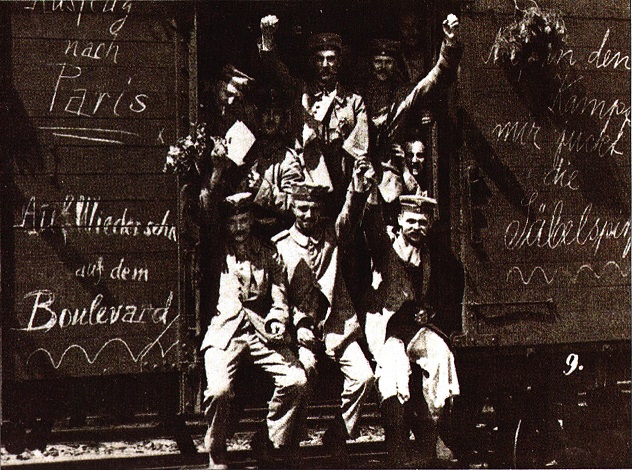
Five steps to World War

Introduction
1 Austria declares war
Austria-Hungary was a world power, but it was afraid of Serbia. Many different races lived in the Austro-Hungarian empire and fifteen different languages were spoken within its borders. If nationalism became popular in Austria-Hungary, the empire would fall apart. Many people in Austria-Hungary wanted to attack Serbia to destroy the Black Hand and 'teach the nationalists a lesson'. Franz Ferdinand had not been very popular in Austria. But his murder gave Austrian politicians the opportunity to get tough with the Serbs. On 23 July 1914, they sent Serbia ten demands. Serbia, they said, must meet all these demands, or they would declare war (this is called an ultimatum).
The Austrians made the terms of the ultimatum very harsh. They hoped the Serbs would have to refuse them, and then Austria-Hungary would have an excuse to invade Serbia.
The Serbs accepted all the points but one. So, on 28 July, Austria declared war on Serbia. The Austrian government, however, had been wrong-footed by the Serbs. The Austrian declaration of war looked unreasonable and unfair. Serbia called up her army and asked her ally, Russia, for help.
2 Russia mobilises
The Russians debated what to do. They knew that Russia was too weak to go to war. However, they did not want to let Serbia down. For Tsar Nicholas, the ruler of Russia, it was a matter of nght and wrong: "An unjust war has been declared on a weak country", he said. On 31 July 1914, he mobilised (called up) the Russian army.
3 Germany attacks
Germany was Austria's ally. The Russian mobilisation threw the Germans into a panic. They had expected a war against France and Russia. They had expected the Russian Army to take a long time to mobilise. The German plan – the 'Schlieffen Plan' – was to march through Belgium, conquer France quickly, and then turn back to face the Russian army. Now the plan was going wrong. Russia was mobilising first, and was going to be ready too soon!
Also, German politicians feared Russia. Russia was weak, but was growing stronger all the time. 1914 was a good time for a war, before Russia got too strong. "We are ready ... and the sooner the better for us", the German General von Moltke said. On 1 August 1914, Germany declared war on Russia. Two days later Germany declared war on France and the German army marched into Belgium.
4 France fights back
Germany attacked France in 1914, but the
French were ready and eager for a fight.
Enthusiastic crowds gathered in Paris to
cheer the soldiers off to war.
5 Britain joins in
In a treaty of 1839, Britain had promised
to defend Belgium if it was invaded. So,
on 4 August, the British government sent
an ultimatum to the Germans demanding
that they promise to withdraw their troops
immediately. The German ministers were
angry and amazed that Britain would
consider going to war 'for a scrap of
paper', but they could not call back their
army.
The deadline for
Germany to accept
Britain's ultimatum was
midnight (11 pm British
time) on 4 August 1914. It was a beautiful
summer's day. All over
Europe cheering crowds
sang patriotic songs
and waved flags. At
11 pm the deadline
passed. Germany had
ignored the British
ultimatum. The crowds
in Parliament Square in
London turned and ran
home in all directions.
As they ran, they
shouted: "War! War! War!"
"Like a line of falling dominoes", one
historian has written, "the nations of Europe
toppled each other over into war".
After you have studied this webpage, answer the question sheet by clicking on the
'Time to Work' icon at the top of the page Apart from Britain, all the countries of Europe had vast armies. Most of their soldiers were 'reservists' – trained soldiers who lived at home, but were ready to be mobilised if there was a war.
Apart from Britain, all the countries of Europe had vast armies. Most of their soldiers were 'reservists' – trained soldiers who lived at home, but were ready to be mobilised if there was a war.
In this picture German soldiers board the train which will take them to their units. The slogans they have chalked on the carriages say things like: 'Excursion to Paris', 'Goodbye to the Boulevard', 'I'm itching to use my sword-point in this struggle'.
Links:
The following websites will help you research further:
GCSE Materials:
• this johndclare.net GCSE page looks at the
Steps to War in more detail
1. "War! War! War"

Interrogating the cartoon:
Does this
photograph prove that all Britons wanted war?
Click here for the answers